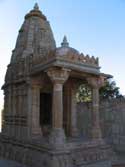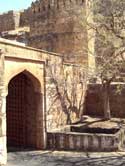Chittorgarh, also called Chittaur, from the 7th century to the 16th, was the capital of Mewar under the Rajputs. Chittaur evokes memories of great heroism and sacrifice by Rajput men and women in the intermittent battles that they had to fight against invaders from Northwest or Delhi. Chittaur witnessed both the ravages of war and the triumphs of the spirit. Allaudin Khilji who coveted Queen Padmini of Chittaur, invaded the city in 1303 A.D. Queen Padmini and the women of the court sacrificed themselves in a pyre of fire rather than submit to anybody. This supreme sacrifice has been called 'Jauhar' and epitomises the fiery spirit of the Rajputs of the day. The city stands strewn with monuments and battlements as evidence of the blood and gore that it went through in medieval times. The Chittaur Fort is the best known fort in Rajasthan. Its origins are traced to the Pandavas of Mahabharata. It is said that Bhima, one of the Pandava brothers, built the fort. Standing on 180 meters high hill, the fort covers an area of 700 Acres. Inside it is the Meera and Khumba Shyam Temple. It is associated with Meera, a mystic poetess devoted to Lord Krishna whose life and bhajans have become part of the folklore and literary traditions of the region and several parts of India.
 Tower of Victory - (Vijay Stambh)There are around 157 narrow steps leading to the terrace where the balconies give a beautiful top angle view of the whole town. When illuminated in the evening, the tower reflects a mesmerizing effect and the view is worth capturing in the camera. |
Tower of Fame - (Kirti Stambh) |
Gaumukh Reservoir A deep tank filled by a spring coming from a 'cow mouth', situated at the edge of the cliff. It is considered to be sacred where you can feed the fishes. |
Rana Kumbha Palace |
Padmini Palace |
Meera Temple (Meera Mandir) |
Kalika Mata Temple (Kalikamata Mandir) |
Fateh Prakash Palace - (Government Museum) Build by Maharana Fateh Singh this huge palace is of morden style. This place has been named Fateh Prakesh after Maharana Fateh Singh. There is a big Ganesh idol, a fountain, and different frescoes which are to be seen to be believed. This palace, now a museum, has a rich collection of sculptures from temples and buildings in the Fort. |
Jain Temples (Jain Mandir - Sattavish devri) At present six jain temples on the fort of Chittor. The largest and chief among them is the temple of Bhagawan Adinatha with fifty-two devkulikas. The place of this temple is known as ‘Sattavish devri’. It means that at some time in the past, there were twenty-seven temples here. The Digamabar Jain Kirtistambh and seven-storied Kirtistambh are two among them. The seven-storied Kirtistambh was built in the fourteenth century in memories of Bhagawan Adinatha. |
Seven Gates of the Fort To enter in to the Fort Of Chittorgarh, the person has to go through seven huge gates(Pol). Each gate is different in its name, design and its size. Below is the list of these gates: 1. Padan Pol 2. Bhairon Pol 3. Hanuman Pol 4. Jorla Pol 5. Ganesh Pol 6. Laxman Pol 7. Ram Pol |
Kerala's # 1 most helpful Tourism blog site. useful site links included in my blogs such topics as:- Travel/Tourism, Health/Resorts/Spa Ayurveda, Theme Parks and Religious/pilgrim centers, Arts/crafts,Real Estate,Agriculture, Books and magazines site links etc., Copyright: Copyrights of this blog and its contents are reserved. Copying contents of this blog is not permitted without prior written permission of its owner.
- Adoor Theme park !
- Ammu regency, Thrissur
- Centralized AC convention center!
- Cheruthuruthy Eco garden !
- Edakkal Cave !
- Jungle Lodges
- KERALA TOURISM GOVT. WEBSITE
- Kalikalam Travels news
- MAGIC PLANET
- Malayalam Tourism Site
- Thrissur Corporation site !!
- Wildplanet Jngle rsrt, Thali, Calicut
- Worldztourism
- akquasun Group Holidays Kchi, CLT.
June 26, 2012
Tourism of Chottorgarh !!
Subscribe to:
Posts (Atom)

